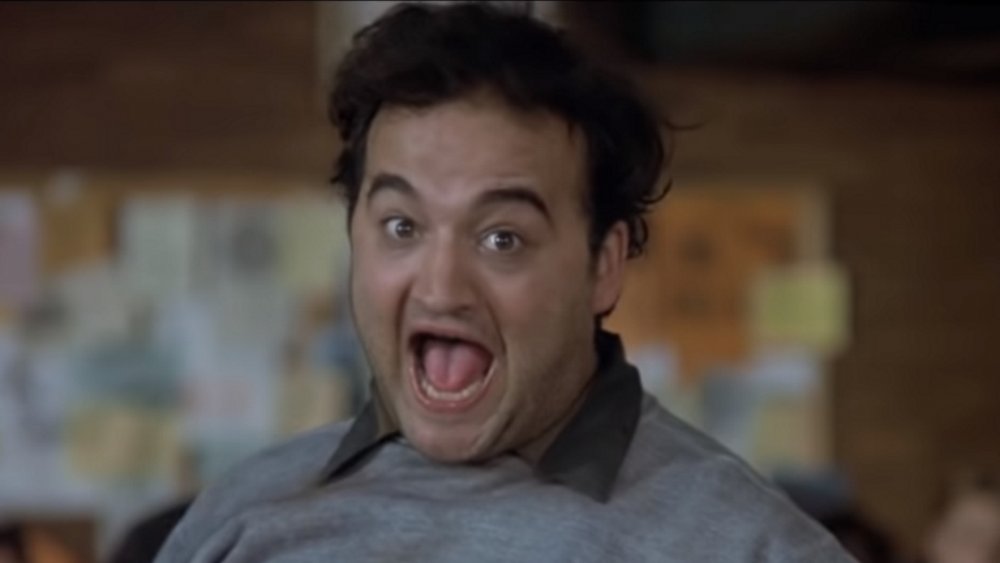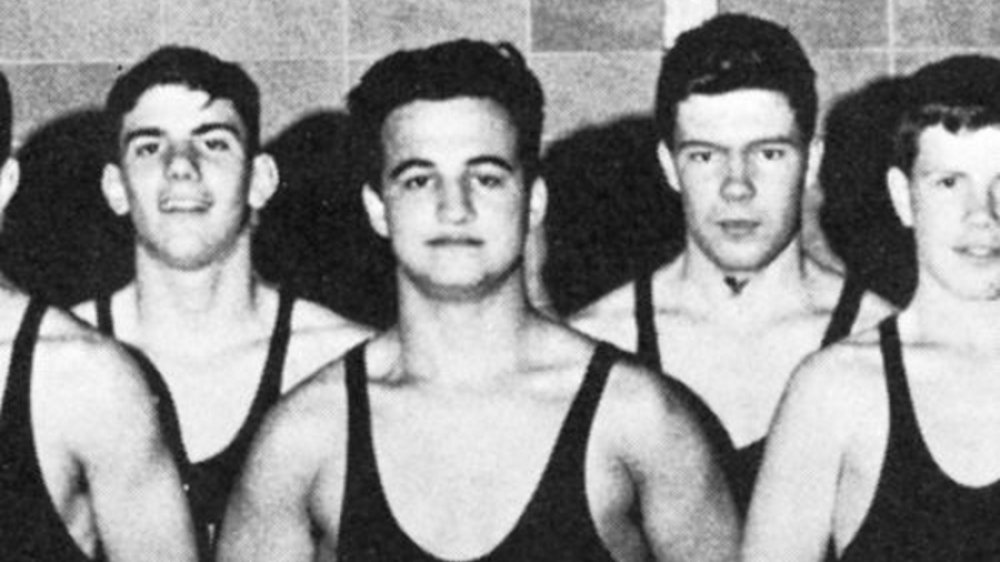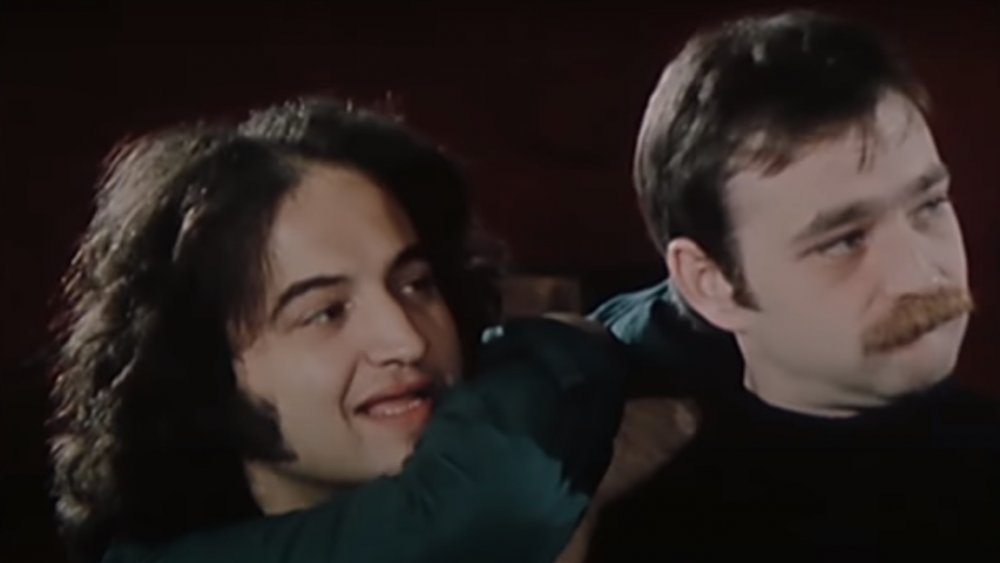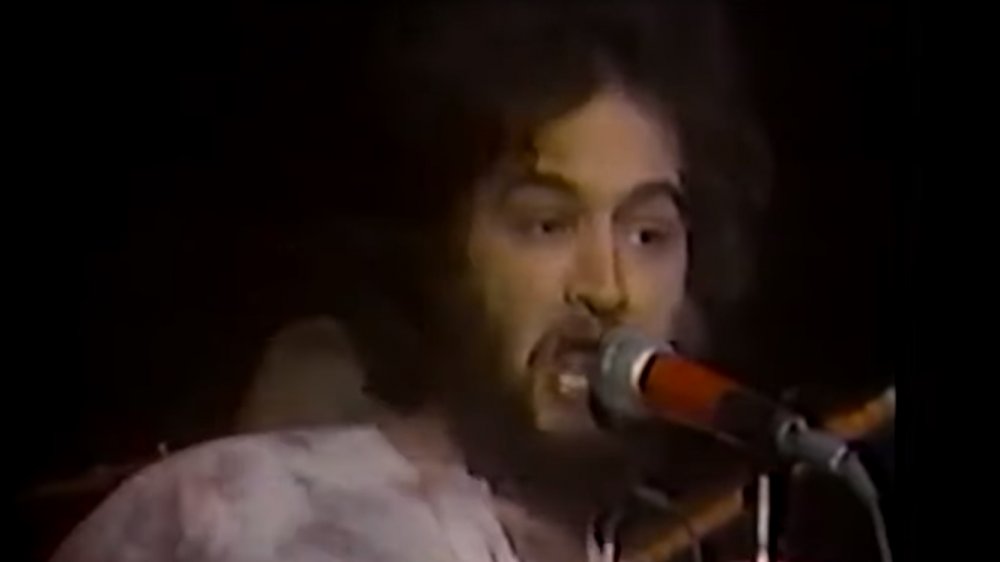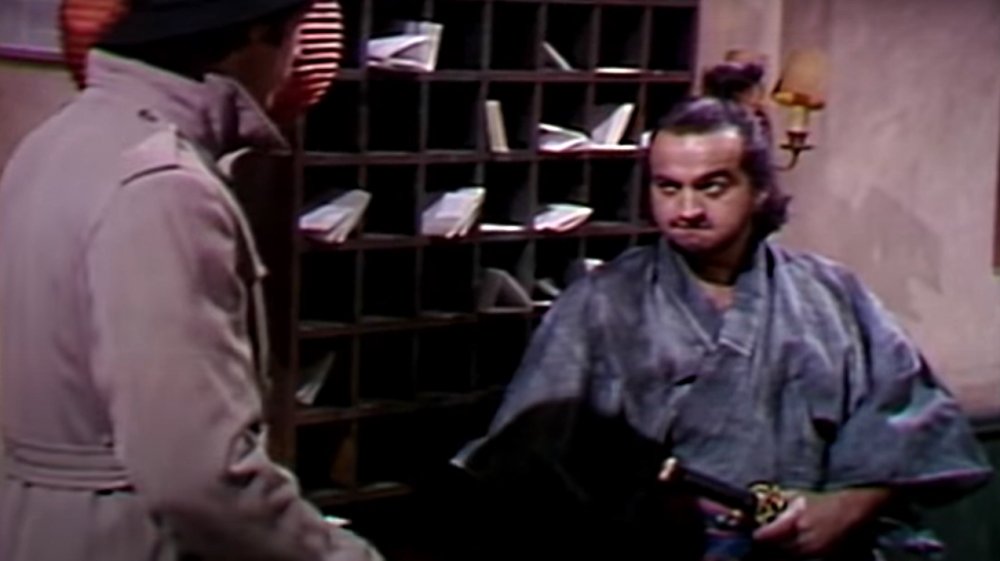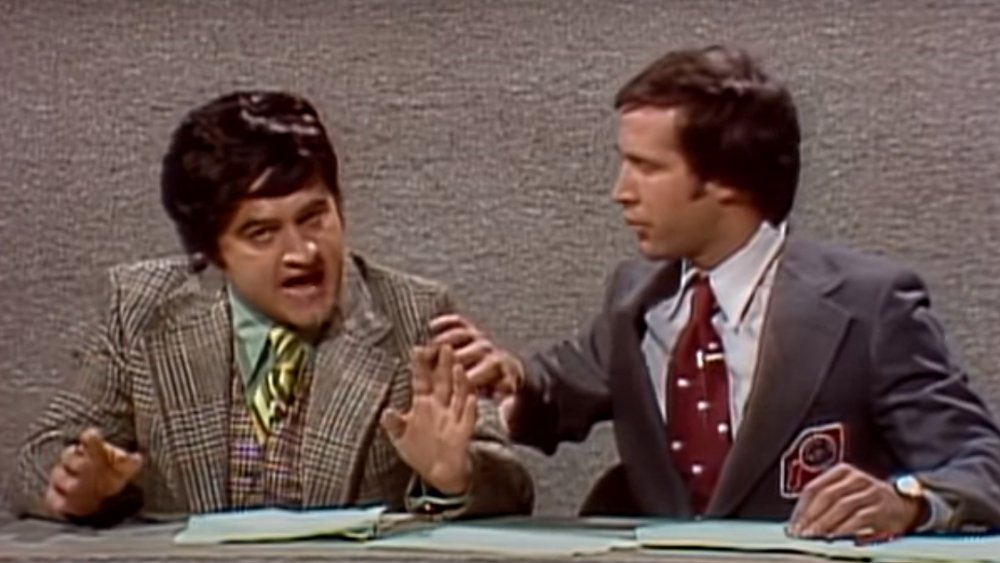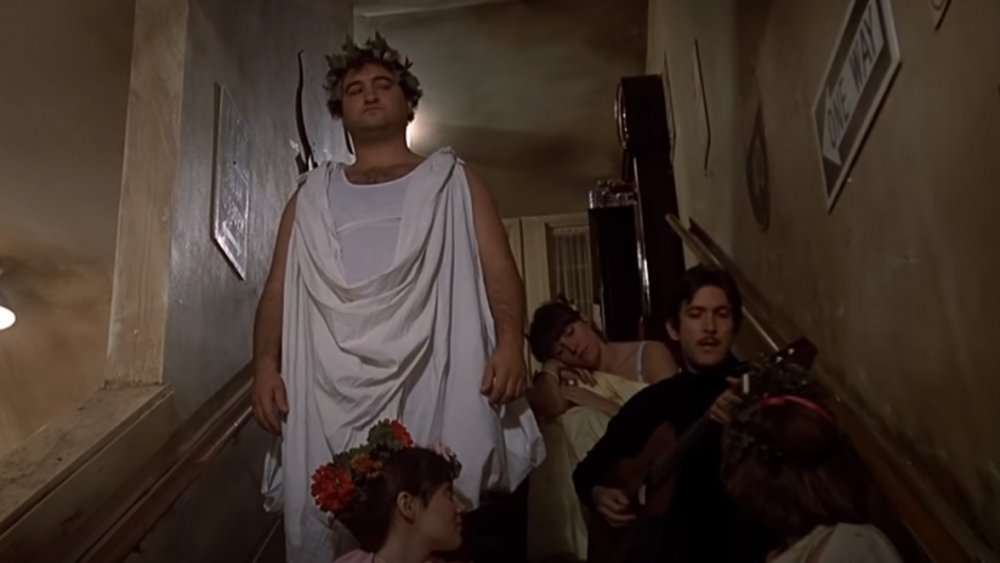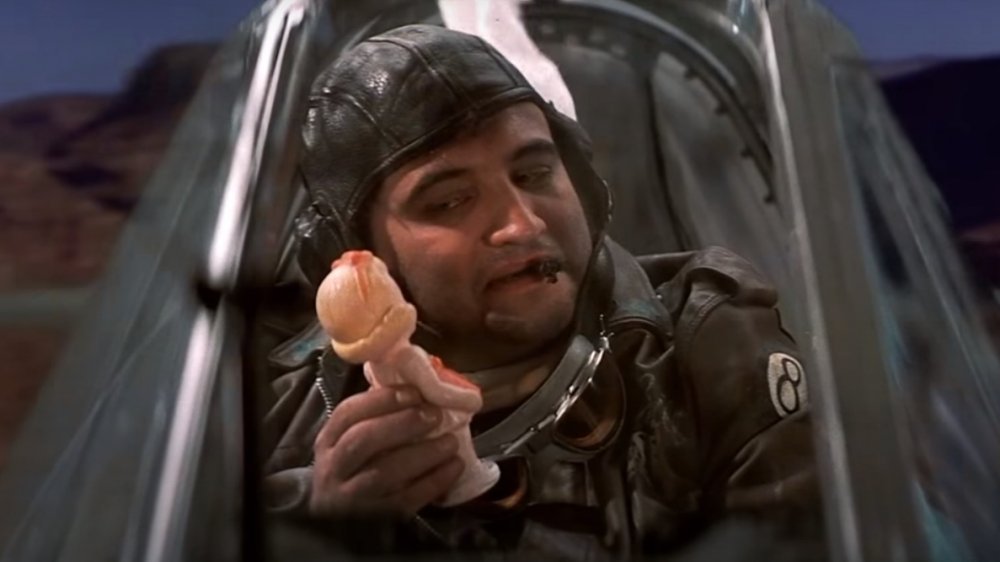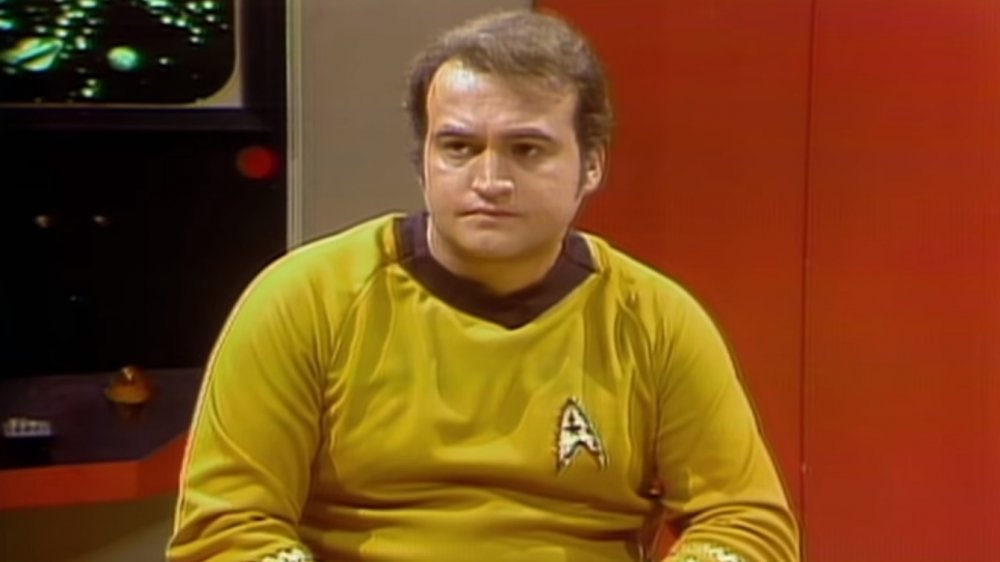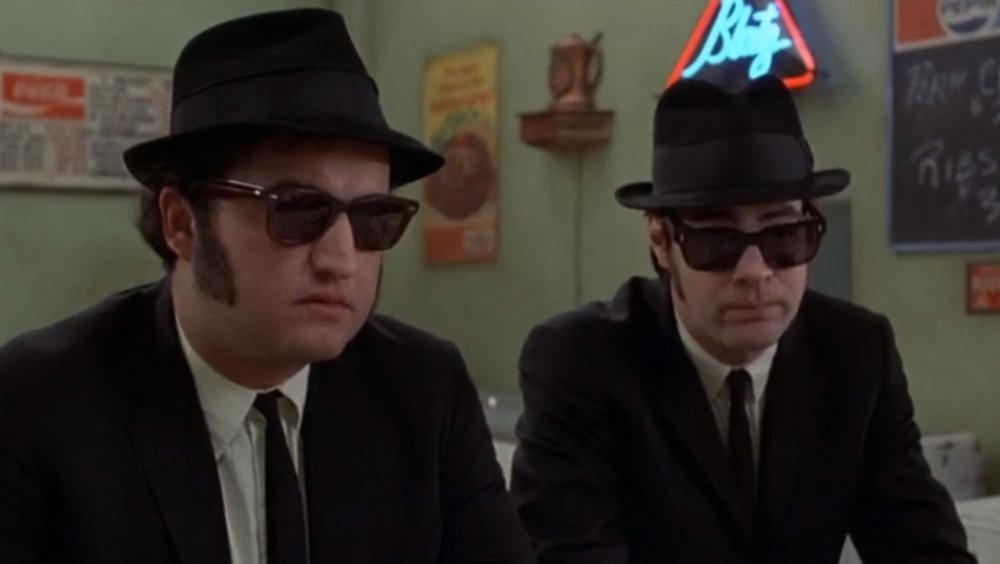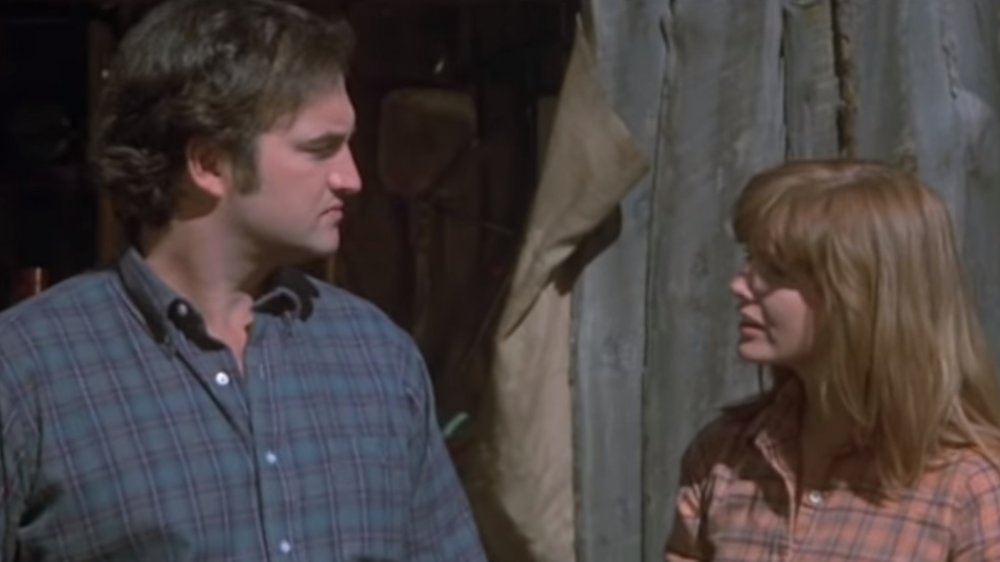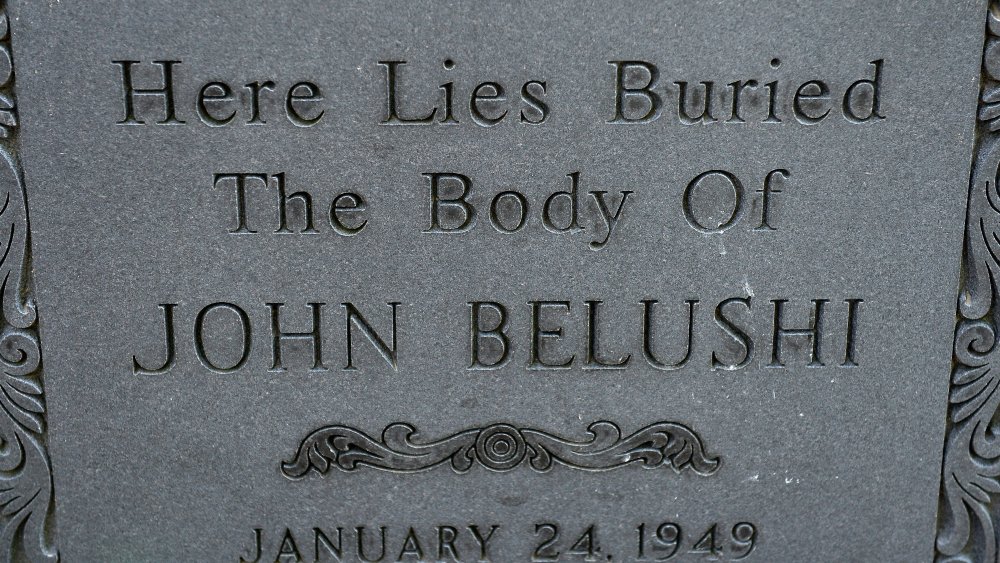The Tragic Real-Life Story Of John Belushi
A gifted comedian, actor, and musician, John Belushi lived a short but eventful life filled with both overwhelming success and heartbreaking tragedy. Rising to national fame as one of the original "Not Ready For Prime Time Players" in the early years of NBC's Saturday Night Live, he created characters that have become indelible features on the pop culture landscape. From his notorious Samurai Mutaba to Pete "Cheeburger" Dionasopoulos to his dead-on impression of singer Joe Cocker, his manic comic genius coupled with his unerring eye of satire made him and the show instant hits with young audiences. Belushi and company made comedy in the 1970s hip, subversive, and dangerous.
Hollywood, unable to ignore his enormous charisma and talent, soon came calling for Belushi. The raunchy 1978 college comedy Animal House, directed by John Landis, made him a movie star and his character, slacker extraordinaire John "Bluto" Blutarsky, a frat house icon. His next Saturday Night Live creation would propel him beyond both TV and film, landing him on the record charts as one half of the legendary musical act the Blues Brothers. Despite the fame, the money, and the accolades, Belushi was, sadly, a victim of his own success. Unable to conquer a deadly addiction to cocaine, the comedian succumbed to the very demons that so often fueled his trademark intensity. Just seven years after his SNL debut, John Belushi was gone — dead at the age of 33. This is his tragic real-life story.
John Belushi struggled with his immigrant heritage
Born January 24, 1949, John Adam Belushi was the eldest son of Albanian immigrants Adam and Agnes Belushi. Raised in suburban Wheaton, Illinois, 25 miles west of Chicago, John lived his life in two distinct worlds. According to a 2019 Guardian article commemorating what would have been the comic's 70th birthday, Belushi's parents' refusal to fit into the American way of life left him feeling like a perpetual outsider. "His parents never assimilated and I think it was hard for John, going to this all-American high school in the day and coming home to this very Albanian family in the evening," says Belushi's widow Judith Belushi-Pisano, who met the comedian when the two were attending high school. Belushi's ethnic looks also set him apart from his largely Anglo peers in the suburbs. "John looked different from all of us — dark, and there was a joke that he was born with a beard. So he was self-conscious of his ethnicity, and he never brought people back to his home — he always went to other people's houses," says Belushi-Pisano.
As recounted on the official John Belushi website Belushi.com, the budding actor couldn't see himself upholding family traditions. Belushi's father, a successful restaurateur who had immigrated from Albania in 1934, believed it was his eldest son's duty to continue the family trade. Determined to blaze his own career path, Belushi repeatedly turned down his father's offers to take over his restaurants
Athlete "Killer Belushi" found solace on the stage
On the surface, young Belushi fit the stereotypical image of the all-American high school kid. A gifted high school athlete, he was the co-captain of his high school football team and an all-conference middle linebacker branded "Killer Belushi" by his classmates. He also wrestled, ran track, and played baseball. A popular student thanks to his quick wit as well as his skills on the football field, he was elected homecoming king his senior year. Not content to be just another jock, he developed interests in drama, forensics, and music. Turning down a football scholarship, Belushi knew that he would find his identity on the stage.
Belushi's high school drama teacher Dan Payne encouraged the young actor's theatrical ambitions and set him on the journey to stardom with a surprise graduation gift in 1967. As described in author Sam Wasson's book Improv Nation: How We Made a Great American Art, Payne's gift of a trip to see the legendary Second City improvisational comedy troupe was a transformational experience for Belushi. He left the theater dazed but filled with a sense of destiny. A few years later, Belushi, as a member of Second City, would say of the stage "[...] that is the only place where I know what I'm doing."
John Belushi bounced from college to college
Although John Belushi may have found his destiny in improvisational theater, he still struggled to find his way academically after high school. Turning down a football scholarship to Western Illinois University, he applied to the exclusive liberal arts school Illinois Wesleyan University. Unfortunately, the elite school turned Belushi down, and he instead enrolled at the University of Wisconsin. After a single year of studies, he returned home to Wheaton and enrolled at the College of Dupage, where he earned an associate of arts degree in general studies.
Still chasing dreams of comedy stardom, he formed his own improvisational troupe called the West Compass Trio with fellow comedians Tino Insana and Steve Beshakes. However, his enthusiasm for (and occasional appropriation of) Second City's bits nearly landed him in hot water with the Chicago improv group. As recounted on Second City's website, they nearly considered legal action. Blown away by Belushi's skills, they hired him as a main-stage performer, instead. At 22, he was the youngest performer ever admitted into the troupe. Working alongside future comedy giants like Joe Flaherty, Brian Doyle-Murray, and Harold Ramis, Belushi made an impression on the Second City veterans.
John Belushi's wild image was at odds with his sensitive soul
Speaking on Belushi's fearlessness, late Second City alumnus Harold Ramis (best known as co-writer and co-star of 1984's Ghostbusters) recalled, "The first night I saw him improvising on stage, I thought, 'God, I will never take chances like that. I don't have that kind of courage.' But there was always something safer and more comfortable about being me than there was about being him." However, those close to Belushi remember him as a loyal man, who, in contrast to the larger-than-life bombast of his characters, was deeply sensitive and empathetic. As detailed in a retrospective in The Guardian, Belushi's sensitivity ran so deep that if his cat fell asleep on his lap, he was likely to be late for rehearsal rather than wake it.
While with Second City, he accepted a job alongside future Saturday Night Live castmate Chevy Chase and comedian Christopher Guest in National Lampoon's musical revue Lemmings. A sendup of the Woodstock music festival, Belushi's uncanny Joe Cocker impression made him a shoo-in. However, his sensitive nature and easily bruised emotions kept him on the outside. Belushi's widow Judith Belushi-Pisano writes in her 2005 book Belushi: A Biography that National Lampoon was "something of a battle for him." She continues, "They [Chase and Guest] had a private school, put-down kind of humour, and John was an easy mark. He was from the midwest, he was overweight, he hadn't graduated from college, he was ethnic — no, even better, he was Albanian. This was all good fodder."
Saturday Night Live didn't want John Belushi
Although John Belushi is now considered virtually synonymous with Saturday Night Live's classic era because of his roster of unforgettable characters and sketches, show creator Lorne Michaels initially rejected him. According to Saturday Night: A Backstage History of Saturday Night Live by Doug Hill and Jeff Weingrad, Michaels didn't want the brash, outspoken comic despite enthusiastic recommendations from SNL cast member Chevy Chase and writer Michael O'Donoghue. Bearded and clad in a T-shirt, jeans, and sneakers, Belushi was a whirling dervish of strong opinions, none of which impressed Michaels. The young comic left with no commitment from Michaels, who suggested he shave and come to the open auditions.
Feeling somewhat insulted by the prospect of auditioning, the Second City and National Lampoon veteran relented. Performing his notorious samurai pool shark hustler routine based on actor Toshiro Mifune, star of director Akira Kurosawa's famous samurai epics Rashomon, The Seven Samurai, and Yojimbo, Belushi blew Michaels away. Still, his position on the show wasn't guaranteed, as Michaels still considered him too brash and too loud and feared his intimidating style would harm the show's carefully constructed balance of performers. Narrowly beating out Bill Murray, who would wind up joining the cast after Chevy Chase's departure, Belushi made the cut, signing his contract a mere 15 minutes before Saturday Night Live's first episode hit the air.
John Belushi fumed over the success of an SNL co-star
The bad blood between Saturday Night Live's first-season breakout star Chevy Chase and the rest of the "Not Ready For Prime Time Players" has become the stuff of showbiz legend. According to Doug Hill and Jeff Weingrad, authors of Saturday Night: A Backstage History (writing for Grantland), Belushi found both Chase's success and the ensuing inflation of his already prodigious ego especially hard. Friendly rivals since their days at National Lampoon, Belushi and Chase's once congenial relationship often degenerated from petty sniping to outright animosity following the latter's sudden ascension. Belushi never missed the opportunity to remind Chase that his performance was the critical hit of Lemmings or that he had beaten Chase in his bid to become National Lampoon Radio Hour's creative director. Chase, in turn, publicly claimed that he had taught Belushi how to eat with a fork.
As Chase's celebrity grew, so did Belushi's contempt for him and the show. Believing Chase to be an inferior talent, Belushi's envy and anger reached a boiling point. Resentful, Belushi felt relegated to second banana status on SNL, stating at the time, "I go where I'm kicked. They throw me bones a dog wouldn't chew on."
Animal House required a grueling schedule
As Saturday Night Live entered its third season in the fall of 1977, John Belushi scored his first film role in Animal House. Directed by John Landis, who would also work with Belushi in 1980's The Blues Brothers, Animal House is a down-and-dirty comedy about the misadventures of the Delta Tau Chi and their endless battle against authority at the fictional Faber College. An ensemble piece filled with broad slapstick, it was the perfect cinematic vehicle for Belushi's skills.
Shot on location in Eugene, Oregon, Animal House required Belushi to maintain a nearly impossible schedule. Not willing to sacrifice his hard-fought success on Saturday Night Live, the comedian chose to make the long flight from New York to Oregon every few days, balancing SNL rehearsals with film shoots. In a 2019 article with The Guardian, director Landis described Belushi as "exhausted" but nonetheless "terrific" in the film. To keep focused and sober, Belushi stayed in a private home away from the rest of the film's cast, who partied nearly as hard as their onscreen Delta House counterparts.
John Belushi followed Animal House with a notorious film flop
John Belushi's next film projects didn't fare as well as his debut. After Animal House, Belushi had a small role in the poorly received 1978 Jack Nicholson comedy-Western Goin' South. However, his next project, the big-budget World War II comedy 1941 directed by Steven Spielberg, would be a disappointment with both critics and audiences. A rare flop for Spielberg, who was hot off the back-to-back successes of Jaws and Close Encounters of the Third Kind, 1941 seemed to value spectacle over story and characterization. In a contemporary review, Chicago Sun-Times critic Roger Ebert wrote, "[...] 1941 feels forced together chaotically, as if the editors wanted to keep the material moving at any cost. The movie finally reduces itself to an assault on our eyes and ears, a nonstop series of climaxes, screams, explosions, double-takes, sight gags, and ethnic jokes that's finally just not very funny."
In addition to the film's poor reception, Belushi's drug habit was spiraling out of control. In a 2014 interview with Yahoo Movies, 1941 co-writer Bob Gale says, "[Belushi's] cocaine problem really got worse during the making of 1941. [...] he'd show up on the set sometimes and he'd look horrible." Nevertheless, Belushi's talent shined despite the toll his habit took on him. Bob Gale recalls, "He'd look like death warmed over. He would perform, do these scenes ... then the next day, in the dailies, it was funny. John had this magic — the camera really liked him."
John Belushi's last year at SNL began a downward spiral
According to Ultimate Classic Rock, John Belushi's final year at Saturday Night Live marked a turn for the worse for the comedy's star's drug use. Throughout the 1978-79 season, Belushi maintained a rigorous filming schedule. Much as he'd done during the filming of Animal House, he flew from New York to Los Angeles weekly to complete work on 1941 and keep his commitment to SNL. Unlike Animal House, however, Belushi had a much larger role and relied on cocaine extensively to maintain his energy.
Despite his increasingly erratic behavior on set, SNL insiders were content to turn a blind eye to Belushi's problem as long as he kept up the quality of his work. In Judith Belushi-Pisano's 2005 book, Belushi: A Biography, she quotes SNL writer Tom Davis on the prevailing attitude toward Belushi's drug use: "He was miserable [...] and hard to work with during blocking and late to the studio, but he'd always get the huge laughs. [...] And as long as he could pull that off, nobody was going to try to change him." Belushi-Pisano remembers her late husband once telling her, "I don't know if I'm coming or going. Sometimes I can't even remember what day of the week it is." Although his next project, The Blues Brothers, a feature-length take on the musical act and characters he developed with SNL co-star and friend Dan Aykroyd, would be the smash hit he longed for, the film also saw his cocaine use spiraling even further out of control.
John Belushi's drug use nearly derailed The Blues Brothers
John Belushi's reliance on cocaine became an all-consuming problem on the set of 1980's The Blues Brothers, with his addiction frequently jeopardizing the production. According to a December 2012 Vanity Fair article chronicling the making of the film, Belushi was aware that he had a serious problem and briefly considered entering rehab but instead chose to continue work on the film. "I'm fine," Belushi insisted to his wife Judith. "I can't stop now until I finish the movie. It'll be fine when it's over." His decision likely worsened his addiction. Director John Landis, concerned for both his star and the fate of his film, attempted to intervene, but his attempts were thwarted by Belushi and his cadre of enablers. A desperate Landis once begged actress Carrie Fisher, herself an addict, "For God's sake, if you see John doing drugs, stop him."
Dan Aykroyd relates that The Blues Brothers had an actual budget devoted to cocaine to keep its star engaged on night shoots. Imbuing Belushi with a near-superhuman stamina, the drug aided the actor in his comic timing, but the aftermath caused frequent delays, pushing the film off schedule and over budget. Staunchly anti-drug and drink, director Landis described The Blues Brothers as a battle to keep Belushi alive and keep him working on the movie.
Two more movie misfires took their toll on John Belushi
Despite the success of The Blues Brothers, Belushi found his options in Hollywood rapidly narrowing. As recounted in a re-evaluation of Belushi's 1981 romantic comedy Continental Divide featured on A.V. Club, the former SNL star's reputation for excess made him a damaged commodity. The comic's behavior was a known factor in driving The Blues Brothers over its already large budget, and Belushi was rapidly becoming too great a risk for filmmakers to take.
Fearing for both his career and his life, Belushi got clean and sober, lost weight, and dove headlong into uncharted territory as a leading man in Continental Divide. In the film, Belushi stars as big-city newspaper reporter Ernie Souchak, who's sent to the Rocky Mountains to write a story about Dr. Nell Porter, portrayed by actress Blair Brown, a scientist studying bald eagles. A romantic, fish-out-of-water story, Continental Divide is devoid of Belushi's typical lowbrow antics, featuring a more nuanced side of his talents. The film received some good notices but failed to find an audience.
Sadly, Belushi's next film, Neighbors, would be his last. Sadder still, it was an unmitigated disaster that found the comedian and his Blues Brothers partner Dan Aykroyd both playing against type with an incomprehensible mess of a script. According to Screen Crush, Belushi clashed frequently with director John Avildsen, suggesting that he be replaced with John Landis. Universally derided by critics, Neighbors managed to turn a profit but remains the last of Belushi's films.
John Belushi lost his battle with drugs at age 33
As recounted in an excerpt from the book The Castle on Sunset by Shawn Levy (via The Hollywood Reporter), an exhausted John Belushi checked into Hollywood's famed Chateau Marmont on February 28, 1982, to work on the script for a project he hoped would be his next hit, a crime caper comedy titled Noble Rot. Checking into his favorite bungalow, the former SNL star was in an obvious state of physical and mental distress. Disheveled, pale, and sweaty, Belushi was sleeping little, missing important meetings, and quite obviously abusing drugs. Along with his prodigious cocaine use, he had also begun using heroin, ostensibly as "research" for a project on punk rock he was developing.
Wife Judith and best friend Dan Aykroyd attempted to bring Belushi out of his deadly descent, to no avail. On the morning of March 5, 1982, Belushi's lifeless body was discovered by his trainer, martial artist Bill Wallace. In circumstances that remain unclear, Cathy Smith, a former rock backup singer, groupie, and notorious drug user, injected Belushi with a deadly cocktail of cocaine and heroin. The resulting overdose killed the already weakened Belushi. He was only 33 years old.
